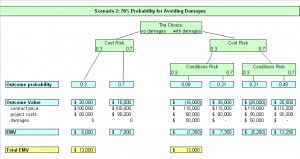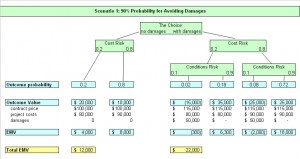Recently, while working on input for a decision tree, I ran into a scenario that reminded me of the fact that we cannot improve a decision simply by applying a tool or technique. We also need good data.
Here is a hypothetical example: Let us assume we are a contractor who is evaluating a fixed bid contract. This contract will pay $115,000 if we accept a clause for liquidated damages of $50,000 in the event we do not meet some project conditions. We can remove this clause from the contract, but in that case it only pays $100,000.
From past experience we know that our project costs will fall somewhere between $80,000 and $90,000 and that the likelihood of coming in at the lower cost estimate is around 20%. This leaves an 80% chance that our costs will come in around $90,000. Looking at our current capabilities we estimate that we have a 90% chance of being able to meet all conditions and thus avoid having to pay damages.
Putting all of this into the decision tree pictured below, we conclude that accepting the liquidated damages clause is the better business decision.
But how good is our estimate for avoiding damages? Can we really trust it? What data do we have to back it up? Have we really considered all the factors that can influence our estimate? After all, as the image below shows, if we are off by only 20 percentage points, the decision becomes a toss up.

A decision tree showing what happens when we lower the assumption for avoiding damages from 90% to 70%
In a decision tree each chance node acts as a weighting factor, so it is worthwhile to pay special attention to events that are estimated to have a very high or very low chance of occurring. We want to be sure that we have good data to back up these optimistic (or pessimistic) numbers.
Of course it is not always feasible to gather all the data we need. Sometimes the data is too expensive given what is at stake, sometimes it is unavailable and sometimes the quality of the data is too unreliable for a given purpose. In that case, experience and judgment need to fill in the data holes. We also call this “making assumptions.”
When making assumptions, we should clearly identify them and decide what to do when one or more of them has to change. We need to
- identify which factors influence our assumptions
- determine how these factors influence the result
- be able to recognize when a significant change in our assumptions is needed
- have a process in place to handle these changes when they do occur.
No one can predict the future with certainty. But the more we understand the probabilities, the better prepared we are.

